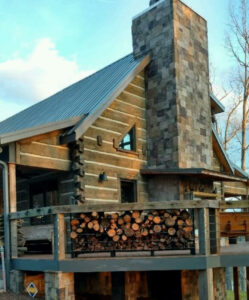
In recent years, home design trends have seen a growing interest in rustic aesthetics, particularly those reminiscent of log cabins. This article delves into the unique attributes of Chattanooga concrete faux log cabin siding, exploring its appeal, production, installation, and ongoing maintenance.
Understanding the Appeal of Faux Log Cabin Siding
Faux log cabin siding has gained popularity for a variety of reasons, combining the charm of traditional log cabins with modern materials. This synthesis not only caters to aesthetic preferences but also addresses practical considerations, making it a desirable choice for homeowners.
The Aesthetics of Log Cabin Siding
One of the primary appeals of faux log cabin siding is its striking resemblance to natural wood logs. Available in various textures and finishes, it can cater to both modern and traditional architectural styles. The rich colors and patterns mimic the look of real wood, providing a warm and inviting facade that enhances curb appeal.
Additionally, the versatility of faux log siding allows for creative applications, whether it be for an entire home or partial accent walls. This adaptability can complement a range of landscaping designs, from mountainous retreats to urban dwellings. Homeowners can choose from a palette of colors that reflect their personal style, ranging from rustic browns to contemporary grays, allowing for a tailored approach that can harmonize with the surrounding environment.
Moreover, faux log cabin siding can be combined with other materials, such as stone or metal, to create unique and eye-catching designs. This blend of textures not only elevates the overall aesthetic but also showcases the homeowner’s creativity and individuality, making each residence a true reflection of its owner’s taste.
Durability and Maintenance of Faux Siding
Unlike traditional wood siding, concrete faux log cabin siding boasts superior durability. It is resistant to decay, insects, and harsh weather conditions, making it an excellent long-term investment. The materials used in the production undergo rigorous testing to ensure longevity, catering to homeowners’ desire for quality and resilience.
Maintenance is also simplified with faux siding. Unlike wood, which requires frequent painting and sealing, faux log siding typically only requires occasional cleaning and inspection. This ease of upkeep contributes significantly to its growing popularity among cost-conscious homeowners. Additionally, many faux log siding products are designed to withstand fading from UV exposure, ensuring that the vibrant colors remain intact for years to come.
Furthermore, the installation process for faux log cabin siding is often more straightforward than that of traditional logs, which can require specialized skills and tools. Many manufacturers provide detailed guidelines and support, allowing DIY enthusiasts to tackle the project with confidence. This accessibility not only reduces labor costs but also empowers homeowners to take pride in their home improvement efforts, knowing they have contributed to the beauty and durability of their residence.
The Process of Creating Concrete Faux Log Cabin Siding
The creation of concrete faux log cabin siding involves a sophisticated process that combines innovation with craftsmanship. Understanding the materials and manufacturing methods can highlight the quality of this siding option.
Materials Used in Faux Log Cabin Siding
Concrete faux log siding is crafted from a blend of aggregates, pigments, and binders, designed to create a durable yet visually appealing product. The aggregates provide essential structural integrity, while the pigments allow for a wide range of color customization, mimicking the look of natural wood.
In addition, modern advancements have led to the implementation of eco-friendly materials, ensuring that many options in faux siding are sustainable. This aligns with a growing consumer preference for environmentally conscious building practices.
The Manufacturing Process
The manufacturing of concrete faux log siding typically begins with sophisticated molds that shape the concrete into log-like profiles. These molds are then filled with the mixture and subjected to curing processes to enhance strength and durability.
Post-curing, the surfaces are often treated with stains or sealants to achieve the desired aesthetic look. The final product undergoes strict quality control checks to ensure they meet durability and visual appeal standards before being distributed to retailers and contractors.
Installation of Chattanooga Concrete Faux Log Cabin Siding
The installation process for faux log cabin siding is straightforward yet requires precision to achieve an optimal finish. Proper installation ensures that the aesthetic qualities are highlighted while maximizing its functional benefits.
Preparing for Installation
Before installation begins, it is crucial to prepare the site effectively. This includes measuring and assessing the area where the siding will be applied, ensuring that the structural integrity of the underlying wall is sound. Any repairs needed on the current wall surface should also be addressed to prevent future problems.
Additionally, having the right tools and equipment is essential for a smooth installation process. This includes cutting tools, adhesives, and safety gear. Planning for these needs ahead of time helps streamline the project.
The Installation Process
The actual installation of faux log cabin siding typically starts from the bottom and works upwards. Adhesives or fasteners are employed to secure the panels in place, ensuring a tight fit that protects against weather elements.
Installation can be a labor-intensive task, requiring expertise to achieve the desired visual outcome. Many homeowners choose to hire professionals who specialize in siding installation to ensure the work is completed to the highest standards.
Cost and Value of Chattanooga Concrete Faux Log Cabin Siding
The financial aspect of installing faux log cabin siding is a significant consideration for many homeowners. Understanding both the initial costs and the long-term value is essential in making an informed decision.
Initial Investment and Installation Costs
The initial investment for concrete faux log cabin siding can vary based on several factors, including the size of the home, complexity of the installation, and the choice of materials. While the upfront costs might be higher compared to traditional siding, the benefits often justify the expenditure.
Installation costs can fluctuate as well, depending on labor rates in the Chattanooga area and any additional features requested by the homeowner. Getting multiple quotes and understanding what is included can help in budgeting effectively.
Long-term Value and Return on Investment
One of the significant advantages of faux log cabin siding is its long-term value. The durability and low maintenance requirements mean that homeowners will likely see a return on investment when it comes to the longevity of their siding.
Moreover, the aesthetic appeal can enhance property values, making homes with faux log siding more attractive in the real estate market. Over time, the reduced upkeep and repair costs contribute to overall savings that further solidify its worth.
Maintenance and Care for Your Faux Log Cabin Siding
To ensure that faux log cabin siding remains in top condition, regular maintenance is crucial. Understanding how to care for this material can significantly extend its lifespan.
Regular Maintenance Tasks
Routine maintenance for faux log siding is relatively simple. Homeowners should aim to inspect the siding periodically for signs of damage or wear. A gentle power wash can effectively remove dirt and debris, keeping the surface clean and vibrant.
Additionally, addressing any cracks or chips as soon as they are noticed will prevent larger issues down the line. Most repairs are straightforward and can be accomplished using recommended repair kits or sealants that match the siding’s color and texture.
Addressing Potential Issues and Repairs
Even with thorough maintenance, potential issues may arise. Common problems include fading due to sun exposure or moisture infiltration. In such cases, applying a fresh coat of sealant or paint can restore the siding’s original appearance and protective qualities.
For extensive damage, consulting with a professional is advisable to assess the level of repairs needed. This proactive approach can mitigate further damage and ensure that the home’s exterior remains well-protected.
Ready to embrace the rustic charm and enduring strength of concrete log siding for your dream home? Look no further than My Smart Logs. Our patented concrete log products offer the authentic texture and timeless appeal of antique hand-hewn logs, combined with the resilience to withstand insects, weather, and time. Ideal for new constructions or retrofitting existing structures, Smart Logs are reinforced for crack resistance and designed for easy handling and installation. Experience the beauty and practicality of an antique log home without the maintenance hassles. Contact Us! to discover how My Smart Logs can bring your vision to life while preserving our forests and saving on insurance costs.
